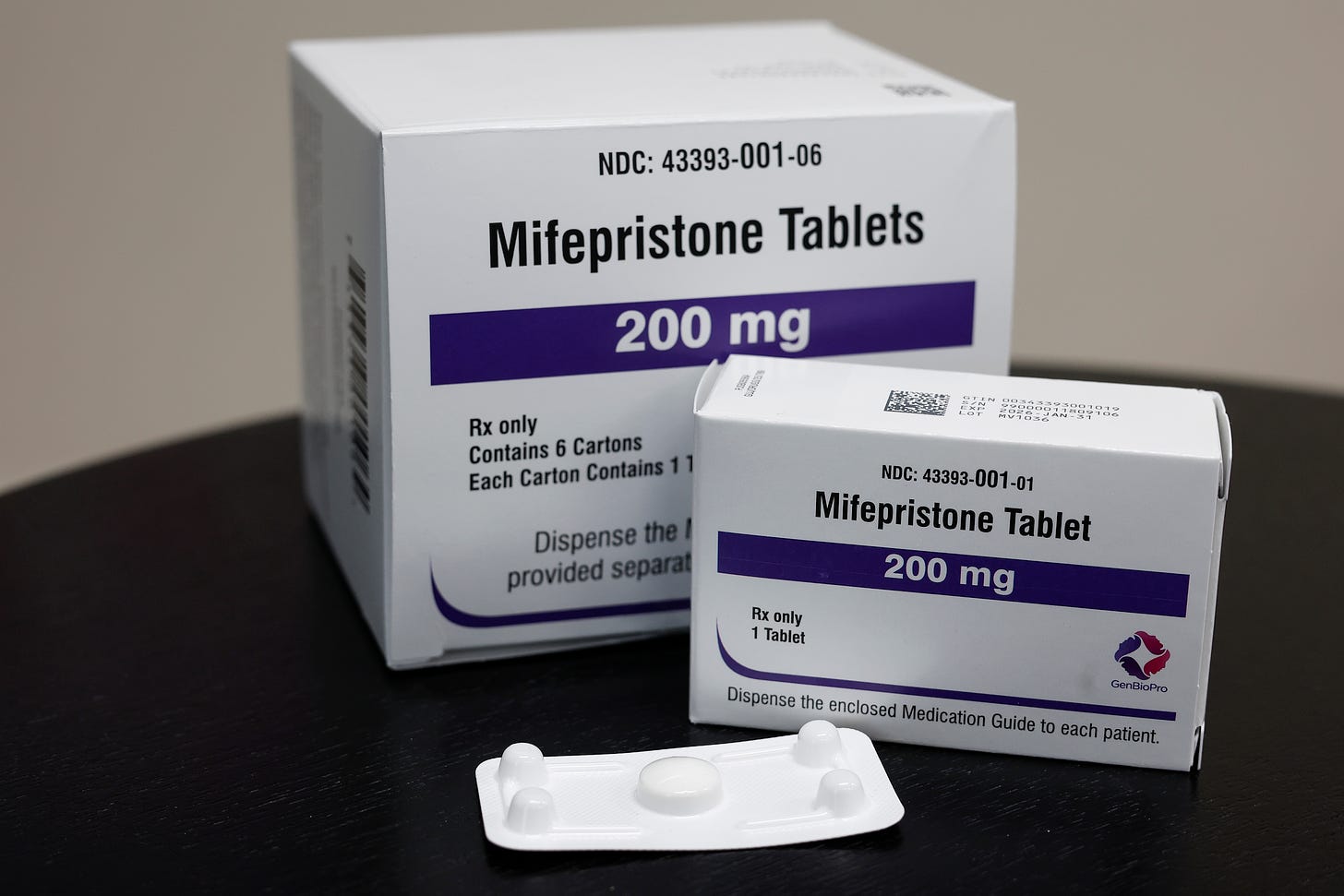SCOTUS Ruling: Mifepristone Access Remains the Same, For Now
Everything you need to know about the ruling and what happens next
Some good news from the Supreme Court this morning. We’ve been waiting on a ruling in FDA v. Alliance for Hippocratic Medicine, the suit challenging access to mifepristone, the first medication in a two-drug regimen to end a pregnancy. The justices ruled unanimously that the plaintiffs—a group of anti-abortion doctors and organizations—lacked standing to challenge the FDA’s regulations on the abortion medication.
That means access to mifepristone remains the same.
What’s important to know is that this is a temporary win. There are other similar cases making their way through the courts, and the ruling itself gives some hints as to what’s coming next. So while we celebrate—which we absolutely should do!—let’s also keep an eye towards the future.
For right now, there’s no overstating how important this decision is for Americans seeking abortion care. Since Roe was overturned, the use of abortion medication has increased drastically: the pills account for 63% of abortions, up from 53% in 2020. And access to the medication, along with telehealth, have prevented the post-Roe care crisis from being even more devastating than it already is. Studies show at least 8,000 people a month in states with bans are having the medication shipped to them from pro-choice states.
That’s why anti-abortion groups are so intent on restricting access to the medication; they know that the pills have been a saving grace for those in anti-abortion states. The medication also undercuts their claims that abortion is harmful; it’s much harder to rail against the supposed danger of abortion when women are able to end their pregnancies safely in their homes.
That didn’t stop them from trying, though.
The Anti-Abortion Argument
While anti-abortion groups want to eradicate access to abortion medication entirely, this case specifically challenged FDA regulations that made mifepristone more accessible—like telehealth options, rules broadening who can prescribe the pill, and allowing the medication to be used up until 10 weeks of pregnancy.
A negative ruling would have meant the drug would only be approved through seven weeks of pregnancy, the medication would have to be prescribed and picked up in person, and mifepristone would be banned from being mailed or prescribed via telehealth.
Rolling back access in that way would have been devastating. Without the ability to have pills shipped to them, patients in states with abortion bans would be stuck—unable to get the care that they need without leaving their state. In pro-choice states, doctors who are already inundated with out-of-state patients seeking procedural abortions would have been even more overwhelmed; and patients across the country would face increased and potentially dangerous delays to care.
Again, that’s why the immediate impact of this ruling is so incredibly important; access to abortion medical remains unchanged.
The groups behind the legal challenge—including the American Association of Pro-Life OBGYNs (AAPLOG), whose president I profiled last week—claimed that mifepristone is dangerous to patients. They used dubious studies, including some that were retracted by their publisher, to support that claim.
The truth? Mifepristone is effective and extremely safe. In fact, it’s safer than Tylenol.
That said, it wasn’t anti-abortion activists’ awful science that ended up losing them the case, but their legal standing to bring the challenge to begin with. Anti-abortion doctors argued that they had legal grounds to bring a suit because they themselves were harmed by seeing the way patients were supposedly hurt by mifepristone.
During oral arguments, though, Solicitor General Elizabeth Prelogar noted that the doctors didn’t come “within 100 miles of the kinds of circumstances” needed to show harm. And Jessica Ellsworth, an attorney for mifepristone manufacturer Danco, pointed out that the doctors “do not use this product, do not prescribe this product, and have a conscience right not to treat anyone who has taken this product.”
Essentially, these activists wanted to stop all American women from having access to a safe and effective drug simply because they disagree with it.
The Ruling
Today’s ruling is the result most experts predicted. The justices’ questions during arguments indicated they didn’t necessarily buy that these anti-abortion doctors/activists suffered moral injury as a result of mifepristone.
Indeed, in today’s SCOTUS decision, Justice Brett Kavanaugh wrote that “a plaintiff ’s desire to make a drug less available for others does not establish standing to sue,” and that “an organization may not establish standing simply based on the ‘intensity of the litigant’s interest’ or because of strong opposition to the government’s conduct.”
That’s terrific—and I’m not trying to downplay what a huge win this is for the folks who will still be able to get abortion medication—but there are a few important things to note about the ruling.
Just because SCOTUS ruled that these groups and doctors don’t have standing doesn’t mean that other anti-abortion activists can’t bring the same case.
Judge Matthew Kacsmaryk, the judge who set this case in motion to begin with, has already allowed Missouri, Kansas and Idaho to intervene in the mifepristone challenge. That means despite today’s ruling, these states could continue the litigation.
In fact, Erin Hawley, the Alliance Defending Freedom attorney who led the mifepristone challenge, said today that those states will continue their suits. The Republican leaders in those three states argue they have standing because states have an interest in ‘protecting’ their residents.
Hawley also said that her group is hopeful because the ruling was “based on a legal technicality,” and that SCOTUS “did not address the merits.”
Now that the SCOTUS ruling is out, anti-abortion activists also have a better sense of what the justices are looking for. As law professor Mary Ziegler wrote today, “One could read parts of this opinion as creating a roadmap to future plaintiffs who *do* want to establish standing.”
Today’s ruling also hinted at a future decision in a different abortion-related case in front of SCOTUS—the lawsuit on EMTALA. From today’s decision:
“Further, the Emergency Medical Treatment and Labor Act (or EMTALA) neither overrides federal conscience laws nor requires individual emergency room doctors to participate in emergency abortions.”
Remember, this is the case in which SCOTUS will decide whether states can ban life-saving abortions. (KFF has a comprehensive explainer here.) There is good reason to be very, very worried about that ruling and what the impact will be.
For more on EMTALA, read my column below:
What’s Next
We already know that Alliance Defending Freedom is going to move forward with their mifepristone challenges for Missouri, Kansas and Idaho. It’s also safe to say that they have other potential plaintiffs in the works with different levels of standing that they hope SCOTUS will accept as legally sufficient. (Rachel Rebouché, dean of Temple University’s law school, predicted as much earlier this year.)
And as POLITICO’s Alice Miranda Ollstein pointed out back in March, conservatives have been preparing for this Supreme Court loss. They didn’t put all of their eggs in one basket. Anti-abortion groups will continue chipping away at everything they can on various fronts—from the bullshit claim that abortion medication poisons the environment and harassment campaigns against pharmacies, to state legislation that ramps up ultrasound requirements, waiting periods and more.
What they’re really banking on, though, is another Donald Trump presidency. If Trump is elected in November, anti-abortion groups can decimate access to abortion medication. Namely, they’ll replace the head of the FDA and use the power of that agency to limit or repeal the drug.
Another Trump administration would also bring with it perhaps the biggest danger to abortion access: the Comstock Act. Under Trump, the Department of Justice could use Comstock to criminalize mailing abortion medication or any tools or supplies used in abortions. This wouldn’t just apply to anti-abortion states, but every state. In effect, it would be a backdoor national ban.1
Abortion rights advocates have been screaming from the rooftops about Comstock since Roe was overturned, urging Congress to repeal the law. (Not-so-fun fact: Clarence Thomas and Sam Alito both brought up Comstock during arguments for today’s mifepristone case.)
All of which is to say: this isn’t over. And as Jamila Perritt, president of Physicians for Reproductive Health, said today, “I don’t want us to lose sight of the fact that we should not have wait with bated breath for courts to decide our reproductive futures.” Truly.
Abortion, Every Day will have more on the SCOTUS ruling and reactions from abortion rights advocates (and foes) tomorrow. In the meantime, let’s celebrate, breathe a sigh of relief, and feel good about today’s win. There’s more work to do, but it will still be there for us tomorrow.
If you found this explainer useful and appreciate Abortion, Every Day, consider becoming a paying supporter! It’s the best way to help the newsletter keep going and growing:
This explainer was compiled with help from AED researcher Grace Haley.
The Comstock Act could also be used to ban the shipping of certain types of contraception, like the morning after pill, that conservatives (falsely) claim are abortifacients.







The cynic in me wonders if all the conservative justices, especially Thomas and Alito, ruled against it so it didn’t look bad politically in an election year, gambling that they can rule against using mifepristone after Trump is elected.
Thanks for the comprehensive explainer (as usual)! This is good news, but ugh, the EMTALA case. So, so worrying. Listening to clips of the arguments in that case was sickening.